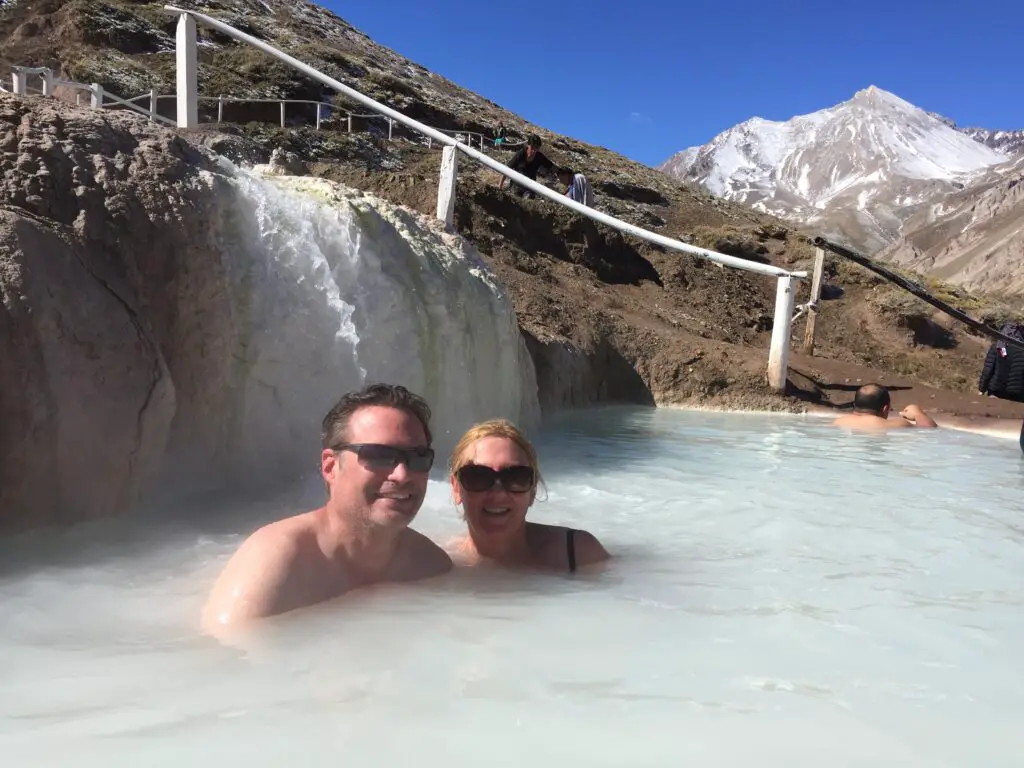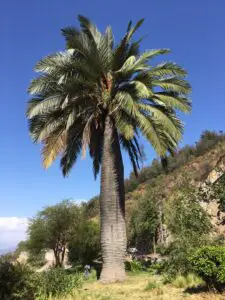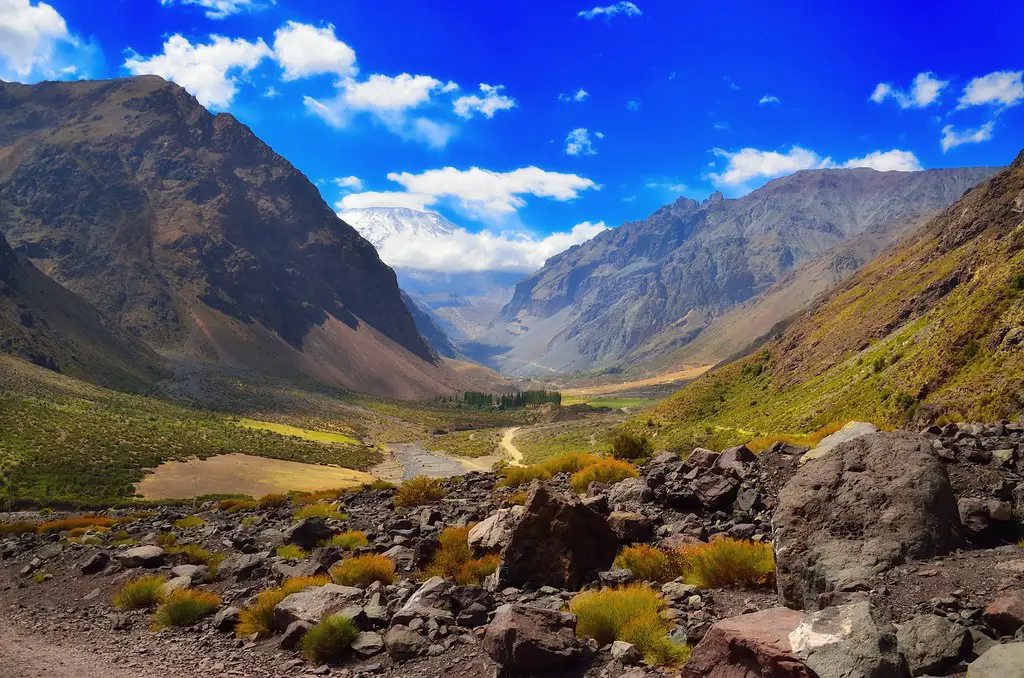Once you have arrived in Santiago, you quickly find out that the best things to see and do are actually not in the city itself, but in the surrounding area. Here are some of my favorites spots to go to for the day.
Some of these places may appear in most guide books as the “classical” things to do or to go, however, there are also some hidden gems that few people (even locals!) know about. Let’s start with Cajon del Maipo, since it covers a lot of different sites in itself.
Table of Contents
Cajon del Maipo, a great getaway for adventure sports

Cajon del Maipo is a deep valley SouthEast of Santiago, which is the easiest and closest to get into the Andes mountains. However, it’s a long valley with different areas and a variety of things. So, you’d better know beforehand where to go exactly.
When you talk to Chileans, for most of them, going to Cajon del Maipo means going to the lower part of the valley and have a typical barbecue in the countryside. While this is nice, this is neither the best thing to do there, nor the most beautiful part of the area. Here are the best activities to do there and places to go, in my humble opinion.
Rafting
The upper part of Maipo river is the best place for rafting near Santiago. There are many different agencies that organize rafting tours. You can also kayak on the river. Please note that this is a rather popular activity: you need to book in advance. Chilerafting.cl is probably the best company to go with.
Rappel
Still a rather confidential activity in the area, which is one of the reasons why it’s great! You will rappel down small canyons and waterfalls. They are many companies that offer these excursions, but I would recommend three of them: Chilerafting.cl, Natexplora.cl, or probably the most reliable, Rutavertical.cl Not sure if they speak English fluently, though.
Horseback riding
A nice way to discover the Andes and to experience the Chilean countryside culture: don’t except fancy helmets and boots: you will ride the Chilean way, with rustic spurs and leather protections. It is imperative to bring sun block, water and a hat for this activity, as the trails are mostly exposed to the strong sun. Cabalgatasinti.cl is the most reliable company to take a horseback ride there.
Hot Springs

There a several hot springs in the area, but the one I recommend is Baños del Valle de Colina, at the very end of the valley. It takes about 3 hours to get there from Santiago, so it’s better to stop and do something else on the way before getting there, like an hour of rafting for example. The last few kilometers are a bumpy dirt road that take you in the middle of impressive mountains, all the way to the hot springs.
It’s not cheap (8,000 pesos, about 10 dollars), considering the lack of infrastructure there – very basic and dirty toilets and showers, and that’s it. But you get to bath in milky blue water, rich in minerals, coming directly from the side of a volcano (you can actually see the source where the water comes from).
It is possible to camp and have a picnic nearby. So if you are not afraid of sleeping at 2,400 meters high with no electricity and no phone reception, an amazing experience is to get into the hot pools at night and watch the milky way with no light pollution whatsoever.
Additional tip: Bring a pair of flip-flops, as the ground between the pools tend to be cold, muddy and slippery. And food and water, as there is nothing for you to buy up there.
Condor watching
In my experience, the best area of Chile to see condors is Southern Patagonia. However, if you don’t have a chance to go all the way down there, there is a very good spot in Cajon del Maipo called Mirador de Condors. It takes a couple of hours of strenuous hiking to get there, but the place is incredible: you will find yourself literally above a cliff where condors have their nest, so you get to watch them flying nearby, sometimes below you. It is better to go there with somebody who knows the area already, as there is no indication and not easy to find by yourselves.
And by the way, if you are into hiking, there are many trails in the upper part of the valley. A beautiful but short hike, and still not too crowded, is going to Las Melosas, a picturesque tiny canyon towards the upper part of the valley. It’s not easy to get there as there are no indications, but you can ask for a map at the tourism office in San Jose de Maipo. Don’t count on Google Maps as you might lose signal on the way there.
Another one is the popular trail to Monumento Natural El Morado, but honestly, I would not recommend this one. First of all, you have to pay to do it, and for a similar length, it’s nicer to get to Valle de Las Arenas, which offers more diversity in terms of landscapes and is much less crowded. But it’s preferable to go there with a mountain guide. Trekking Andino offers an array of excursions in the area.
And finally, where NOT to go to
If you have read or heard about the famous lake Embalse El Yeso, here is my advice on that: don’t go. First of all, this is place has gotten overcrowded over the past few years, to the point where it’s not enjoyable anymore. The two typical things to do there are walking around the lake and having a picnic. However, it’s a narrow dirt road to get there, and since it’s windy, you will receive all the dust from every single car driving by.
And more importantly, the level of the lake is going down every year. Last fall, before the first rains arrived, it came to a point where it was very low, and most of the place’s beauty were lost. Finally, there was a couple of deadly accidents there, so Carabineros (the police) has decided to close the road until further notice.
How to get there
Cajon del Maipo is not very well deserved by public transportation. The easiest way is to take the subway all the way down to Plaza de Puente Alto (Line 4). And from there, take a rural bus that drives through the Cajon del Maipo valley with turmaipo.cl.
If you are taking a rappel, rafting or horseback riding activity, most companies have their office in the main town of San Jose de Maipo and can pick you up there. However, if you want to go to the hot springs, Mirador de Condores or La Melosa, or you will need to hire private transportation or come with your own car.
Finally, you will need cash to pay for the bus, for the hot springs, and for pretty much everything in Cajon del Maipo, as it is a rural area and many places don’t accept credit cards.
Palmar de Ocoa, one of the last palm tree forrests left in Chile

Palmar de Ocoa is one of the last three remaining palm tree forrests in Chile, and the largest one. It is also the most beautiful of the three, as it is located in the mountains – not in the Andes, but the Coastal Range. In fact, it is part of La Campana National Park, but it’s the most unknown and underrated part of the park.
Beautiful and peaceful, with easy hikes:
La Campana is pretty well-known amongst Chileans as a mountain. Climbing to the summit is quite a popular day hike, as you get a 360-degree view from the top. On a clear day, you can see both the snow-capped Andes and the Pacific ocean. However, the palm tree forrest is located in another sector of the national park. And whereas La Campana trek is often crowded, and is a mid-to-difficult 7-hour hike, the palm tree forrest is widely unknown, and offers easier hikes – and the place is both peaceful and beautiful.
Palm trees, cactus and wildlife
Besides the towering and imposing palm trees (some of them are 600 years old and more!) you will also see many cactus, and if you are lucky, some wildlife, including quails, hummingbirds and quails, among others.
Private transportation needed
To get there, you will need private transporation, preferably a car with high clearance since the last few kilometers are on rocky roads. It is roughly a 2-hour drive from Santiago. You will need to pay an entry fee in cash. Note that there is no facility at all and no phone service in the area: you must bring your own water and food – and go to the toilets when you pay the entrance.
Visit an Alpaca farm in Llay-Llay

I hesitated quite a bit before mentioning this place, because this one is really off the beaten path, and it’s not somewhere where you can just come without notice. Quintessence Alpacas is a farm that raises hundreds of alpacas, including babies, where you can visit the place, learn about the animals, pat them, and also visit the workshop with all the machines to process the fiber and the wool. They do everything there, from the birth of the animal to the final products that they sell on their shop: gloves, scarves, jackets, etc.
Take a private tour
But this is a working place, so while they welcome visitors, you need to book in advance and come there with private transportation. We recommend to take a private tour with Chile Private Tours (LINK IN MY BIO), one of the few companies that go there. In fact, it is a good idea to combine the palm tree forest and the alpaca farm in the same day.

Avid traveler, journalist and writer, he moved away from his native France back in 2006 and settled in Chile. After visiting the country North to South, learning extensively about its culture, History, gastronomy, Thomas started to work as a tour guide. He liked it so much that he ended up creating his own tour agency in Valparaiso, where he lives today. You can visit my site at: https://chileprivatetours.com/
